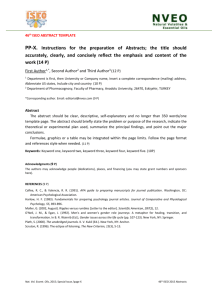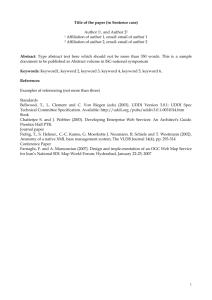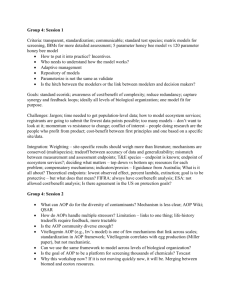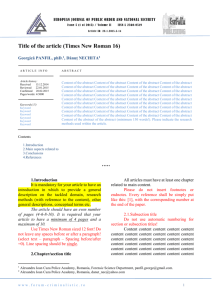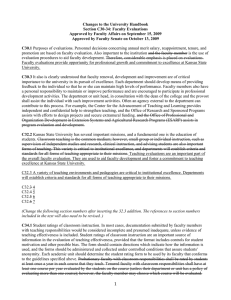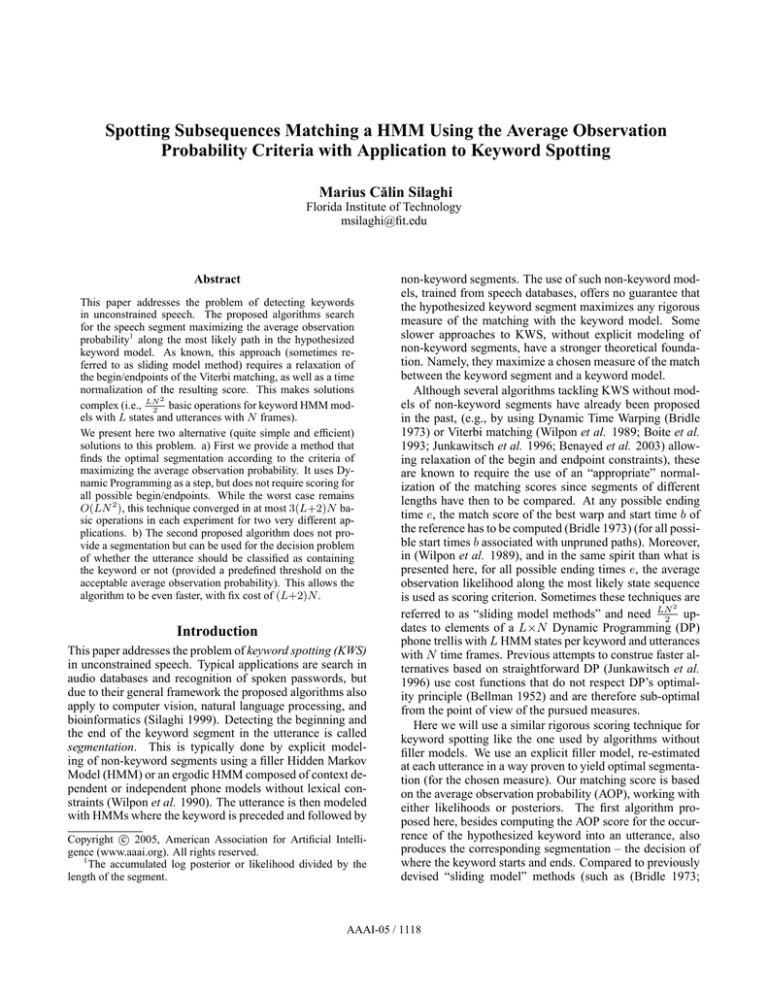
Spotting Subsequences Matching a HMM Using the Average Observation
Probability Criteria with Application to Keyword Spotting
Marius Călin Silaghi
Florida Institute of Technology
msilaghi@fit.edu
Abstract
This paper addresses the problem of detecting keywords
in unconstrained speech. The proposed algorithms search
for the speech segment maximizing the average observation
probability1 along the most likely path in the hypothesized
keyword model. As known, this approach (sometimes referred to as sliding model method) requires a relaxation of
the begin/endpoints of the Viterbi matching, as well as a time
normalization of the resulting score. This makes solutions
2
complex (i.e., LN
basic operations for keyword HMM mod2
els with L states and utterances with N frames).
We present here two alternative (quite simple and efficient)
solutions to this problem. a) First we provide a method that
finds the optimal segmentation according to the criteria of
maximizing the average observation probability. It uses Dynamic Programming as a step, but does not require scoring for
all possible begin/endpoints. While the worst case remains
O(LN 2 ), this technique converged in at most 3(L+2)N basic operations in each experiment for two very different applications. b) The second proposed algorithm does not provide a segmentation but can be used for the decision problem
of whether the utterance should be classified as containing
the keyword or not (provided a predefined threshold on the
acceptable average observation probability). This allows the
algorithm to be even faster, with fix cost of (L+2)N .
Introduction
This paper addresses the problem of keyword spotting (KWS)
in unconstrained speech. Typical applications are search in
audio databases and recognition of spoken passwords, but
due to their general framework the proposed algorithms also
apply to computer vision, natural language processing, and
bioinformatics (Silaghi 1999). Detecting the beginning and
the end of the keyword segment in the utterance is called
segmentation. This is typically done by explicit modeling of non-keyword segments using a filler Hidden Markov
Model (HMM) or an ergodic HMM composed of context dependent or independent phone models without lexical constraints (Wilpon et al. 1990). The utterance is then modeled
with HMMs where the keyword is preceded and followed by
c 2005, American Association for Artificial IntelliCopyright gence (www.aaai.org). All rights reserved.
1
The accumulated log posterior or likelihood divided by the
length of the segment.
non-keyword segments. The use of such non-keyword models, trained from speech databases, offers no guarantee that
the hypothesized keyword segment maximizes any rigorous
measure of the matching with the keyword model. Some
slower approaches to KWS, without explicit modeling of
non-keyword segments, have a stronger theoretical foundation. Namely, they maximize a chosen measure of the match
between the keyword segment and a keyword model.
Although several algorithms tackling KWS without models of non-keyword segments have already been proposed
in the past, (e.g., by using Dynamic Time Warping (Bridle
1973) or Viterbi matching (Wilpon et al. 1989; Boite et al.
1993; Junkawitsch et al. 1996; Benayed et al. 2003) allowing relaxation of the begin and endpoint constraints), these
are known to require the use of an “appropriate” normalization of the matching scores since segments of different
lengths have then to be compared. At any possible ending
time e, the match score of the best warp and start time b of
the reference has to be computed (Bridle 1973) (for all possible start times b associated with unpruned paths). Moreover,
in (Wilpon et al. 1989), and in the same spirit than what is
presented here, for all possible ending times e, the average
observation likelihood along the most likely state sequence
is used as scoring criterion. Sometimes these techniques are
2
referred to as “sliding model methods” and need LN
up2
dates to elements of a L×N Dynamic Programming (DP)
phone trellis with L HMM states per keyword and utterances
with N time frames. Previous attempts to construe faster alternatives based on straightforward DP (Junkawitsch et al.
1996) use cost functions that do not respect DP’s optimality principle (Bellman 1952) and are therefore sub-optimal
from the point of view of the pursued measures.
Here we will use a similar rigorous scoring technique for
keyword spotting like the one used by algorithms without
filler models. We use an explicit filler model, re-estimated
at each utterance in a way proven to yield optimal segmentation (for the chosen measure). Our matching score is based
on the average observation probability (AOP), working with
either likelihoods or posteriors. The first algorithm proposed here, besides computing the AOP score for the occurrence of the hypothesized keyword into an utterance, also
produces the corresponding segmentation – the decision of
where the keyword starts and ends. Compared to previously
devised “sliding model” methods (such as (Bridle 1973;
AAAI-05 / 1118
Wilpon et al. 1989)), the algorithms proposed here reestimate a filler model, using Viterbi decoding which does
not require scoring for all begin/endpoints, and which can
be proved to (quickly) converge to the “optimal solution”
(from the point of view of the chosen scoring function, i.e.,
AOP). Each re-estimation step uses straightforward Viterbi
alignments (similar to regular filler-based KWS).
For a specific sub-sequence Xbe , expression (1) can easily be estimated by dynamic programming since the subsequence and the associated normalizing factor (e − b + 1)
are given and constant. However, in the case of keyword
spotting, this expression should be estimated for all possible
begin/endpoint pairs {b, e} (as well as for all possible word
models), and we define the matching score of X and M as:
AOp(M, X) = AOp(M, X, b∗p , e∗p )
Measures and Notations
P(q1|q1)
P(q2|q2)
P(q2|q1)
q1
P(x|q1)
q2
where the optimal begin/endpoints {b∗p , e∗p }, are the ones for
the path Q∗p yielding the lowest average local log posterior
P(q3|q3)
P(q3|q2)
P(x|q2)
x
hb∗p , e∗p i = argmin AOp(M, X, b, e)
q3
Average Observation Likelihood
x
The average observation likelihood (AOl) of a subsequence
Xbe given a model M is defined as the average of the log
likelihood along the optimal path, i.e.:
Figure 1: A simple progressive left-to-right HMM.
A continuous Hidden Markov Model (HMM) (Jelinek
1999; Russell & Norvig 2002), see Figure 1, is defined by
a set of states Q = {q1 , . . . , qL } with a unique starting
state, a space of possible outputs (for speech recognition,
typically the space of Mel-frequency cepstrum coefficients
feature vectors), a set of transition probabilities P (qi |qj ),
∀i, j ∈ [1..L], and a set of probability density functions
defining the likelihood of each possible output for each state.
Let X = {x1 , . . . , xN } denote the sequence of acoustic vectors in which we want to detect a keyword, and let
M be the HMM model of a keyword and consisting of L
states Q = {q1 , . . . , qL } where q1 is the starting state and qL
the final one. Assume that M is matched to a subsequence
Xbe = {xb , . . . , xe } (1 ≤ b ≤ e ≤ N ) of X, and that we
have an implicit (not modeled) garbage/filler state qG preceding and following M . Thus we implicitly introduce the
grammatical constraint that we recognize one keyword occurrence, preceded and followed by non-keyword segments.
Average Observation Posterior
The average observation posterior (AOp) of a model M
given a subsequence Xbe is defined as the average of the log
posterior probability along the optimal path, i.e.:
1
min − log P (Q|Xbe )
e − b + 1 Q∈M
1
=
min {− log P (q e |xe )
e − b + 1 Q∈M
e−1
X
[log P (q n |xn ) + log P (q n+1 |q n )]}(1)
−
AOp(M, X, b, e) =
n=b
b
b+1
(3)
{b,e}
P(x|q3)
x
(2)
where Q = {q , q , ..., q e } represents any of the possible
paths of length (e − b + 1) in M , and q n the HMM state
visited at time n along Q, with q n ∈ Q. The local posteriors
P (qk |xn ) can be estimated as output values of a multilayer
perceptron (MLP) as used in hybrid HMM/Neural Network
systems (Bourlard & Morgan 1994).
1
min − log P (Xbe , Q)
e − b + 1 Q∈M
1
min {− log P (xe |q e )
=
e − b + 1 Q∈M
e−1
X
[log P (xn |q n ) + log P (q n+1 |q n )]}(4)
−
AOl(X, M, b, e) =
n=b
The local likelihoods P (xn |qk ) can be estimated using gaussian models, etc. (Young 1996). The matching score of X
and M according to this criteria is defined as
where
AOl(X, M ) = AOl(X, M, b∗l , e∗l )
(5)
hb∗l , e∗l i = argmin AOl(X, M, b, e)
(6)
{b,e}
The computation of the AOp and AOl measures is similar,
except for the estimation of the local posterior, respectively
likelihood. An important factor in deciding which of them
should be used is the implementation of the acoustic classifier: gaussians, neural networks, etc. For simplicity in the
following we assume that we use posteriors. However, all
further discussions apply straightforwardly if posteriors are
replaced with likelihoods.
Given the time normalization and the relaxation of begin/endpoints, straightforward DP is no longer optimal and
has to be adapted, usually involving more CPU. A new (and
simple) solution to this problem is proposed in this paper.
Background
Let us summarize the techniques that compute the same output as the algorithms proposed here or/and that are used as
intermediary steps in our techniques.
Filler-based KWS
Although various solutions have been proposed towards the
direct optimization of (2) and (5) as, e.g., in (Bridle 1973;
Wilpon et al. 1989), most of the KWS approaches today
AAAI-05 / 1119
prefer to preserve the simplicity of Viterbi DP by modeling the complete input X (Rohlicek 1995). This is done
by explicitly (Rose & Paul 1990) or implicitly (Boite et
al. 1993) modeling non-keyword segments, using so called
filler or garbage models as additional reference models. We
assume that non-keyword segments are modeled by extraneous garbage models/states qG (and grammatical constraints
ruling the possible keyword/non-keyword sequences).
In this paper, we will consider only the case of detecting one keyword per utterance at a time. In this case, the
keyword spotting problem amounts at matching the whole
sequence X of length N onto an extended HMM model M
consisting of the states {q0 , q1 , . . . , qL , qL+1 }, in which q0
and qL+1 are tied (i.e., share emission probabilities) to the
garbage model state qG . A path of length N in M (whose
segment contained in M is Q = {q b , ..., q e }) is denoted
=
k∈[1..L]
return V [N %2, L];
Algorithm 1: Function of whether MLE or MAP is used,
P rob[i, j] is − log P (xi |qj ) respectively − log P (qj |xi ).
N −e
b−1
z }| {
z
}|
{
Q = {q0 , ...q0 , q b , q b+1 , ..., q e , qL+1 , ...qL+1 } with (b − 1)
b
garbage states q0 preceding q and (N − e) states qL+1 following q e , and respectively emitting the vector sequences
N
X1b−1 and Xe+1
associated with the non-keyword segments.
Given some estimation εt of − log P (qG |xn ), the optimal
path Qt (and, consequently segmentation bt and et ) using
the posteriors criteria is then given by:
Qt
function ViterbiScoring(M , X, P rob)
foreach k from 2 to L, V [1, k] = ∞;
V [1, 1] = P rob[1, 1];
foreach i from 2 to N do
u = i%2; // index i is used mod 2 to save space;
foreach j from 1 to L do
V [u, j] = P rob[i, j]+
min (V [1−u, k] − log P (qj |qk ));
2.1
function SlidingModel(M , X, P rob)
score = ∞;
foreach b from 1 to N −1 do
foreach k from 2 to L, V [b%2, k] = ∞;
V [b%2, 1] = P rob[b, 1];
foreach i from b+1 to N do
u = i%2;
foreach j from 1 to L do
V [u, j] = P rob[i, j]+
min (V [1−u, k] − log P (qj |qk ));
k∈[1..L]
argmin − log P (Q|X)
V [u,L]
score = min (score, (i−b+1)
);
if score changed then b∗ ← b, e∗ ← i;
∀Q∈M
=
argmin{− log P (Q|Xbe )
∀Q∈M
return (score, b∗ , e∗ );
+(b−1) log P (q0 |q0 ) + (N −e) log P (qL+1 |qL+1 )
−
b−1
X
log P (qG |xn ) −
n=1
N
X
log P (qG |xn )}
Algorithm 2: Sliding Model Method.
(7)
n=e+1
which can be solved by straightforward DP, all paths having the same length (see Algorithm 1). The main problem
of filler-based keyword spotting approaches is then to find
ways to best estimate P (qG |xn ) in order to minimize the error introduced by the approximations. In (Boite et al. 1993)
this value is set to the average of the K best local scores (for
some value K). In other approaches it is generated by training explicit filler HMMs. These approaches will usually not
lead to the “optimal” solutions given by (2), (5).
Viterbi decoding retrieves the most probable path through
a HMM M that generates a certain observation X. Its first
step uses a DP algorithm computing the probability of the
best path through M given X (i.e., Equation 7). This DP in
the first step of Viterbi is isolated in Algorithm 1 (ViterbiScoring), which returns the score of the best path. It uses an
array V storing in each V [i, j] the score of the best path of
length i in M that starts at the start state and ends in state qj .
For the so called criteria of Maximum A Posteriori (MAP),
Algorithm 1 uses local posteriors. For Maximum Likelihood
Estimation (MLE), it uses local likelihoods. (Jelinek 1999;
Bourlard & Morgan 1994)
Sliding Model Method
The sliding model method (Wilpon et al. 1989), see Algorithm 2, returns the Average Observation Probability (poste-
rior or likelihood) of the best match of the keyword model
with a segment of the observation. This is done by computing the score for each segment. It reuses the partial results
between segments starting at the same frame. If the basic
operation is the computation at Line 2.1, then the cost is
LN (N −1)/2. {b∗ , e∗ } denote the optimal segmentation.
Segmentation by Filler Re-estimation
1
q0
P(q1|q1)
q1
1
P(q2|q2)
P(q2|q1)
P(x|q1)
P(x|qG)=e
x
q2
P(x|q2)
x
1
P(q3|q3)
P(q3|q2)
q3
q4
P(x|q3)
x
P(x|qG)=e
x
x
Figure 2: Keyword with Filler Model for SFR
In the following we define a method referred to as Segmentation by Filler Re-estimation (SFR) with good/fast convergence properties, estimating a value for − log P (qG |xn )
(or − log P (xn |qG ) when using likelihoods) such that
straightforward DP for computing (7) yields exactly the
same segmentation (and recognition results) than (3). While
the same result is achieved through the sliding model
method the algorithm proposed below is more efficient.
AAAI-05 / 1120
3.1
function SegmFillReest(M , X, P rob, ε)
foreach k from 1 to L+1 do V [0, k] = ∞;
V [0, 0] = 0;
while true do
foreach i from 1 to N do
u = i%2;
P rob[i, 0] = P rob[i, L + 1] = ε;
foreach j from 0 to L+1 do
v = argmin (V [1−u, k] − log P (qj |qk ));
k∈[0..L+1]
b[u, j] = (v == 0)?i : b[1−u, v];
V [u, j] = P rob[i, j]+
(V [1−u, v] − log P (qj |qv ));
3.2
[u,L+1]−εN
ε = Ve[u]−b[u,L+1]
+ ε;
if ε unchanged then break;
3.4
Algorithm 3: Segmentation by Filler Re-estimation. The ε
parameter may take any value. Theoretically the algorithm
may be faster if ε is closer to the result. Experimentation
shown that it made little difference in practice.
SFR is based on the same HMM structure as the filler
based approaches (7). However, rather than looking for
explicit (and empirical) estimates of P (qG |xn ) we aim at
mathematically estimating its value (which will be different and adapted to each utterance) such that solving (7) is
equivalent to solving (3). Here qG is a special emitting state
whose emission probability density function is not normalized, but is constant (see Figure 2). Also, the transition probabilities from/to garbage states are not normalized (equaling 1). As such, continuing to use the probability notations
with (7) would be an abuse of language and we rewrite it using ε instead of − log P (qG |xn ), ε having only an algebraic
significance. The estimation of ε at step t is denoted εt .
Qt = argmin{− log P (Q|Xbe ) + (b−1+N −e)εt } (8)
∀Q∈M
Thus, we perform a converging re-estimation of ε, such
that the segmentation resulting of (8) is the same than what
would be obtained from (3), and we sometimes called it Iterating Viterbi Decoding (IVD) (Silaghi 1999).
SFR2 can be summarized as follows (see Algorithm 3):
1. Start from an initial value3 ε0 , (e.g., with ε0 equal to 0 or
to a cheap estimation of the score of a “match”).
2. Find Qt (and bt , et ) according to (8) (Lines 3.1 to 3.3).
3. Update the estimated value of ε to the average of the local posteriors along the keyword segment of the path Qt ,
(Line 3.4) i.e.,:
−1
log P (Qt |Xbett )
εt+1 = AOp(M, X, bt , et ) =
(et − bt + 1)
Patent (Silaghi 1999)
In Appendix, it is actually proven that SFR will always converge to the same solution (in more or less cycles, with the worst
case upper bound of N loops) independently of this initialization.
3
We note from the definition of AOp that ∀ b, e,
AOp(M, X, b, e)≥AOp(M, X, b∗ , e∗ ).
(9)
Lemma 2 (decrease if εt > AOp(M,X)) If
εt >AOp(M, X), then the path computed with (8) is
Qt with AOp(M, X, bt , et )<εt .
Lemma 3 (shrinking path) If εt > εt+1 , then either
et+1 − bt+1 < et − bt or we have reached convergence.
return (ε, b[u, L+1], e[u]);
2
Lemma 1 (AOp(M,X) is a fix point) If εt = AOp(M, X)
given by (2), then solving (7) yields hQ∗ , b∗ , e∗ i given by (3).
Theorem 1 The series {hQt , bt , et i}t , defined with the recursion εt+1 = AOp(M, X, bt , et ) where Qt , bt , et are
computed from εt with (8), converges to the unique fix point
hQ∗ , b∗ , e∗ i.
e[u] = (v ≤ L)?i : e[1−u];
3.3
4. If εt+1 6= εt , then increment t and return to Step 2.
The proof of these propositions appears in Appendix:
each SFR cycle (from the second one) decreases the estimation of ε, and the final path yields the same solution than (3).
Corollary 1.1 SFR converges in maximum N cycles.
Proof. From the previous lemma and from Lemma 2 we
notice that at each step before convergence (starting with
the 2nd ), the length of Qt decreases. The number of steps is
therefore roughly upper bounded by N .
Another way of proving the convergence of SFR (which
yields weaker bounds for termination) consists in proving
the equivalence of SFR with a slightly less efficient version
where ε is subtracted in each cycle from each element of
P rob. This new version can then be proven equivalent to
an instance of (W.Dinkelbach 1967)’s procedure for a zeroone fractional programming problem with real coefficients.
Details appear in (Silaghi 2005), as well as application to
other criteria.
Since SFR is proven to terminate in at most N cycles,
its proven worst cost is N 2 (L+2) basic operations, where
the basic operation in SFR adds Line 3.2 to the basic operation of the Algorithm 2. While SFR’s theorethical worst
case is more than twice worse than the fix (best case) cost
of Algorithm 2, SFR always converged in 3 cycles in the experiments described further, leading to an expected cost of
3N (L+2), which is much better (N ’s value is between 176
and 1097 in our database). Moreover, absence of a keyword
can be decided from the first iteration (see the next section).
Decision by Filler Re-estimation
A typical usage of keyword spotting is to detect the presence of some keyword in an utterance (without caring for the
segmentation). If the score of the matching is above some
threshold T , then a positive detection is declared.
Lemma 4 When the estimation of ε is initialized with T , if it
increases at the first iteration then the match will be rejected,
otherwise it will be accepted.
Proof. From (9) it follows that whenever ε0 has a smaller
value than the fix point, the first re-estimation will transform
it in a value bigger than the fix point, i.e., ε1 > ε0 . If ε0 has
AAAI-05 / 1121
a larger value than the fix point, the first re-estimation will
yield a smaller value, ε1 < ε0 (Lemma 2). Therefore the
direction of change in the first re-estimation of ε tells if the
initialization value was smaller or bigger than the fix point.
If we only want to know how T compares to the fix point
(which is the score of the match), it follows that we can learn
this in one cycle by setting ε0 to T .
function DecisionFillReest(M , X, P rob, T )
foreach k from 1 to L+1 do V [0, k] = ∞;
V [0, 0] = 0;
foreach i from 1 to N do
u = i%2;
P rob[i, 0] = P rob[i, L + 1] = T ;
foreach j from 0 to L+1 do
V [u, j] = P rob[i, j]+
mink∈[0..L+1] (V [1−u, k] − log P (qj |qk ));
return V [u, L] > T N ;
Algorithm 4: Decision by Filler Re-estimation.
The obtained algorithm is called Decision by Filler Reestimation (DFR) (see Algorithm 4) and roughly consists of
a cycle of SFR. The basic operation (defined as for the sliding model method) is performed only N (L+2) times.
Experimental results
Our algorithms and the sliding model method were compared on the BREF database (Lamel, Gauvain, & Eskénazi
1991), a continuous, read speech microphone database. 242
utterances (with a 2, 300 word lexicon), were used for testing. These keywords were represented by simple hybrid
HMM/ANN models based on context-independent phones.
On this database, the average speedup of SFR (13.867.986
DP updates/keyword) vs. sliding model (1.241.899.326 updates/keyword) is 89.5 times. SFR gives the same results
as the sliding model method (confirming the soundness of
the implementation). For computing the segmentation, 3 iterations were needed in each experiment. While it may be
believed that the fast convergence was due to lucky choices
of databases and keywords, the same fast convergence was
observed for all keywords in the database and for also for a
very different application to natural language parsing of another version of our algorithm (Rosenknop & Silaghi 2001).
DFR is SFR which stops after the first (out of 3) iterations. DFR is obviously 3 times faster than SFR and yields
the same result. For building a ROC curve it is preferable
to use SFR since DFR would have to be run again for each
computed point of the curve. However, for production systems (working at a predefined point) DFR is preferable.
The use of likelihoods versus posteriors is dictated by
the technology used for the probabilistic estimation, since
ANNs return posteriors and most other learning techniques
compute efficiently only likelihoods. It is more rigorous to
use posteriors than likelihoods, since the likelihoods-based
criteria is an approximation of the posterior-based criteria.
Certain results suggest that posteriors perform also experimentally better than likelihoods (Bourlard & Morgan 1994).
However, experimental methods have not yet been devised
to separate the influence of the difficult to evaluate quality
of the training of different estimators.
We do not provide here the comparison between recognition with AOP scoring versus other scorings, since
these comparisons have been thoroughly studied elsewhere (Wilpon et al. 1990; Silaghi & Bourlard 2000). In
a summary, some other scores work better than AOP with
certain keywords and databases, and vice-versa. AOP’s advantage is that it is not a black-box but a rigorous measure
and its behavior improves understanding of keyword spotting. Other criteria that we proposed are the double normalization and the real fitting (Silaghi 1999).
Conclusions
We have thus proposed new methods for keyword spotting (KWS), working with both local likelihoods and local
posterior probabilities, and optimizing rigourously defined
matching scores (the average observation probability) between keyword models and keyword segments. The fastest
previous algorithm with this property is Sliding Model requiring exactly N 2 L/2 basic operations, a prohibitive cost.
A first proposed algorithm, Segmentation by Filler Reestimation (SFR), computes the same output like Sliding
Model but much faster: 3N (L+2) measured in two very
different experimented applications, KWS and NLP, even
if its theorethical worst case cost is O(N 2 L). A second
proposed algorithm, called Decision by Filler Re-estimation
(DFR) returns the same matching decision like SFR and
sliding model methods, but does not compute the segmentation (which is not required in many applications). However its cost is fix, N (L+2) of the same basic operations like in sliding model method. Proof is given in Appendix. Typical applications are search in audio databases
and recognition of spoken passwords, but due to its use of
the general HMM framework, the proposed algorithms have
been shown to have applications in computer vision, natural language processing, and bioinformatics (Silaghi 1999;
Rosenknop & Silaghi 2001).
Acknowledgements
We thank Hervé Bourlard for the trained ANNs used in experiments, and Giulia Bernardis for help in setting up the
Bref database.
Appendix
Lemma 1 (AOp(M,X) is a fix point) If εt = AOp(M, X)
given by (2), then solving (7) yields hQ∗ , b∗ , e∗ i given by (3).
Proof. Let us note AOp(M, X) with w. We see from definitions that − log P (Q∗ |X) = N ∗ w. A suboptimal path
Qeb would have yielded − log P (Qeb |X) = N ∗ w + (e − b +
1) ∗ (w0 − w) > N ∗ w since w 0 > w from the definition
of AOp. Here we have noted by w 0 the value of the average
log probability in the suboptimal path Qeb , i.e.:
1
w0 = AOp(M, X, b, e) =
− logP (Qeb |Xbe ) > w
e−b+1
AAAI-05 / 1122
References
Since DP yields the optimum, it chooses Q∗ .
Lemma 2 (decrease if εt > AOp(M,X)) If
εt >AOp(M, X), then the path computed with (8) is
Qt with AOp(M, X, bt , et )<εt .
Proof. Let us denote AOp(M, X, bt , et ) with w0 and
AOp(M, X) with w.
− log P (Qt |X) = (N − 1 − et + bt ) ∗ εt + (et − bt + 1) ∗ w0
(i.e., contribution of non-keyword segments ’+’ contribution of keyword segment). Since the path Q∗ was not preferred:
− log P (Qt |X)≤ − log P (Q∗ |X)
This can be written as: (N − 1 − et + bt ) ∗ εt + (et − bt +
1) ∗ w0 ≤(N − 1 − e∗ + b∗ ) ∗ εt + (e∗ − b∗ + 1) ∗ w.
After reordering we obtain: (et − bt + 1) ∗ w0 ≤(N − 1 −
∗
e + b∗ ) ∗ εt + (e∗ − b∗ + 1) ∗ w − (N − 1 − et + bt ) ∗ εt ,
and by regrouping the right term:
(et −bt +1)∗w0 ≤(e∗ −b∗ +1)∗w+((et −bt )−(e∗ −b∗ ))∗εt
(10)
Since e∗ − b∗ + 1 > 0 and from the hypothesis that w < εt :
(e∗ −b∗ +1)∗w+((et −bt )−(e∗ −b∗ ))∗ε < (et −bt +1)∗εt
(11)
From the inequalities (10) and (11):
(et − bt + 1) ∗ w0 < (et − bt + 1) ∗ εt
et − b t + 1 > 0 ⇒ w 0 < ε t .
If Q∗ was preferred, then again w 0 = w < εt .
Theorem 1 The series {hQt , bt , et i}t , defined with the recursion εt+1 = AOp(M, X, bt , et ) where Qt , bt , et are
computed from εt with (8), converges to the unique fix point
hQ∗ , b∗ , e∗ i.
Proof. From inequality (9), after the 2nd step we have
ε≥AOp(M, X). From Lemma 2, each further cycle of the
algorithm decreases ε.
From Lemma 1 and Lemma 2, results that the convergence appears at AOp(M, X, bt , et ) = AOp(M, X). Since
the number of possible paths is finite, it converges.
Lemma 3 (shrinking path) If εt > εt+1 , then either
et+1 − bt+1 < et − bt or we have reached convergence.
Proof. Let us denote wt = AOp(M, X, bt , et ) and wt+1 =
AOp(M, X, bt+1 , et+1 ). Since Qt was preferred to Qt+1
for ε = εt , it means that εt (bt −et +N −1)+wt (et −bt +1) ≤
εt (bt+1 − et+1 + N − 1) + wt+1 (et+1 − bt+1 + 1).
εt ((et+1 − bt+1 ) − (et − bt )) + (et − bt + 1)wt − (et+1 −
bt+1 + 1)wt+1 ≤0 (12)
If for ε = εt+1 (εt+1 < εt ), we would obtain Qεt+1 with
et+1 − bt+1 ≥et − bt , (et+1 − bt+1 ) − (et − bt )≥0, then by
adding (εt+1 − εt )((et+1 − bt+1 ) − (et − bt ))≤0 to inequality (12) we obtain:
εt+1 ((et+1 − bt+1 ) − (et − bt )) + (et − bt + 1)wt − (et+1 −
bt+1 + 1)wt+1 ≤0
showing that Qεt will still be preferred to Qεt+1 . If Qεt 6=
Qεt+1 then this is a contradiction and we can infer that
et+1 − bt+1 < et − bt . Otherwise we have Qεt = Qεt+1 and
we reach convergence with et+1 − bt+1 = et − bt .
Bellman, R. 1952. On the theory of dynamic programming.
Proc. of the National Academy of Sciences 38:716–719.
Benayed, Y.; Fohr, D.; Haton, J.; and Chollet, G. 2003.
Confidence measures for keyword spotting using suport
vector machines. In ICASSP.
Boite, J.-M.; Bourlard, H.; d’Hoore, B.; and Haesen, M.
1993. A new approach towards keyword spotting. In EUROSPEECH, 1273–1276.
Bourlard, H., and Morgan, N. 1994. Connectionist Speech
Recognition - A Hybrid Approach. Kluwer.
Bridle, J. 1973. An efficient elastic-template method for
detecting given words in running speech. In Brit. Acoust.
Soc. Meeting, 1–4.
Jelinek, F. 1999. Statistical Methods for Speech Recognition. MIT Press.
Junkawitsch, J.; Neubauer, L.; Höge, H.; and Ruske,
G. 1996. A new keyword spotting algorithm with precalculated optimal thresholds. In ICSLP, 2067–2070.
Lamel, L.-F.; Gauvain, J.-L.; and Eskénazi, E. 1991. Bref,
a large vocabulary spoken corpus for french. In Proceedings of EuroSpeech’91.
Rohlicek, J. 1995. Word spotting. In Ramachandran, R.,
and Mammone, R., eds., Modern Methods of Speech Processing. Kluwer. 123–157.
Rose, R., and Paul, D. 1990. A hidden markov model based
keyword recognition system. In ICASSP’90, 129–132.
Rosenknop, A., and Silaghi, M.-C. 2001. Algorithme de
décodage de treillis selon le critère de coût moyen pour la
reconnaissance de la parole. In TALN’01.
Russell, S., and Norvig, P. 2002. Artificial Intelligence, A
Modern Approach. Prentice Hall, 2nd edition.
Silaghi, M.-C., and Bourlard, H. 2000. Iterative posteriorbased keyword spotting without filler models. In Proceedings of the IEEE Intl. Conf. on Acoustics, Speech, and Signal Processing.
Silaghi, M.-C. 1999. Speech recogn. and sign. anal. by
search of subsequences with maximal confidence measure.
PCT patent WO 00/51107.
Silaghi, M. C. 2005. Iterative segmentation in keyword
spotting: relation to fractional programming. Technical
Report CS-2005-11, FIT.
W.Dinkelbach. 1967. On nonlinear fractional programming. Management Science 18(7):492–498.
Wilpon, J.; Rabiner, L.; C.-H., L.; and Goldman, E. 1989.
Application of hidden markov models of keywords in unconstrained speech. In Proc. of ICASSP’89, 254–257.
Wilpon, J.; Rabiner, L.; Lee, C.; and Goldman, E.
1990. Automatic recognition of keywords in unconstrained
speech using hidden markov models. IEEE Trans. on ASSP
38(11):1870–1878.
Young, S. 1996. A review of large-vocabulary continuousspeech recognition. IEEE Signal Proc. Magazine 45–57.
AAAI-05 / 1123


